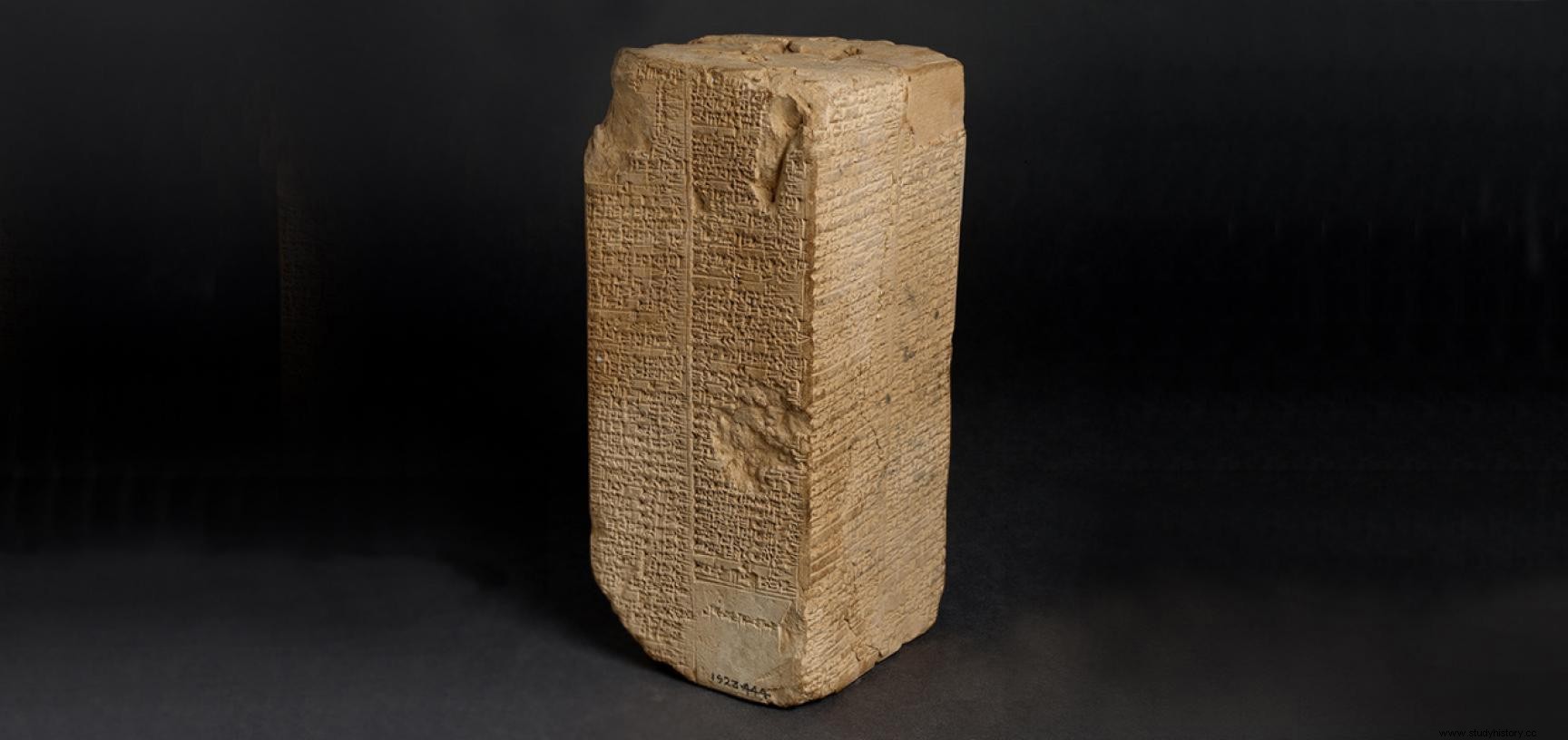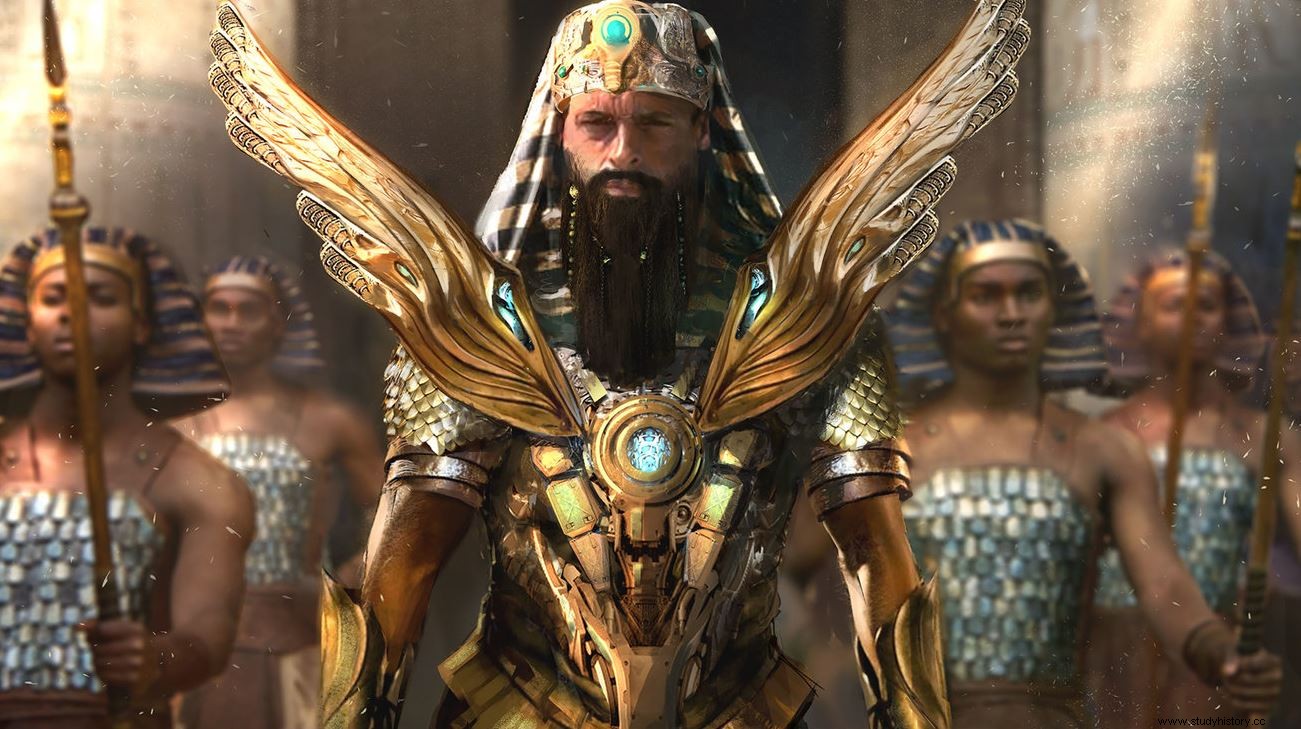If we go through the Ashmolean Museum in Oxford we will see a famous object on display. Specifically, it is a block of baked clay covered with cuneiform writing. It is known as Weld-Blundell Prism , by the name of the expedition that discovered it during the excavations of the Sumerian city of Larsa in 1922. It is more popularly known as the Sumerian Royal List . It consists of a list of names of kings who would have reigned in Sumer since archaic times. It is so popular that it has even become the Holy Grail to which some individuals cling, wearing a cone of aluminum foil, to ensure that there were extraterrestrial gods who came down to earth. The bad thing is that the object cannot be taken as a history book, but as a simple guide with errors included.

We can divide the sovereigns into three parts. In the first, the kings who supposedly ruled first appear, with enormous periods of government, such as Enmenluana with 43,200 years or Dumuzid with 36,000. Its existence and personal data are, to say the least, uncertain. The second part consists of kings who might have existed. We assume this because slight indications of the existence of some have been found, such as Mebaragesi of Kish or Gilgamesh and Enmerkar of Uruk. Of course, if they did exist, they weren't that handsome, or that tall and slender, or Angelina Jolie's boyfriends. Let's say your data is somewhat embellished. For something there are historians who call it "heroic age". The periods of reign do not quite add up either. For example, the only queen on the list, Kug-Bau of Kish, is given 100 years. Due to signs found on some tablets, we suppose that there were more around 20. The third part presents lists of monarchs of whom we are aware, and this is where we come across the origin of the document and its problems. To begin with, it should be noted that it is not the only list that has been found, as there are other more partial and older ones, such as that of Nippur. It's not too old either. It was made at the end of the Isin Dynasty, which corresponds to the Sumerian twilight. It is, so to speak, very “modern”. It is believed to be based on an earlier list that would have been written at the beginning of the Third Dynasty of Ur, a few hundred years earlier.

And why was such a list created? Was there, perhaps, an intention behind it to preserve the historical memory of the kings? Well, rather not. The reason seems to have been more banal:to justify coups.
We find the first of them, precisely, in the III Dynasty of Ur, which was founded when Ur-Nammu, a Sumerian general, gave his king Utu-hegal a good kick, seizing the crown and founding the dynasty. The rest we see in the Isin Dynasty, at the end of which the list was created, possibly during the reign of Sin-Magir, the penultimate king. The time in which the kings of Isin lived was very turbulent. The Sumerian cities no longer had a clear hegemony that united them, as during the III Dynasty of Ur. So, they acted independently, almost like the cities of Renaissance Italy, intriguing among themselves, warring, allying and later betraying the ally... like gangsters. And among them, the city of Isin tried to be the most important, although others like Larsa frustrated them from time to time. Kings such as Ishbi-Erra, founder of the dynasty, Ur-Ninurta or Erra-Imitti came to office after rebelling or fast-tracking their predecessor into retirement, surely through some original, creative and withering system, as was customary in that area of the world (the Akkadian king Rimush had his skull crushed with a stone seal). As if that were not enough, Ur-Ninurta had been a priest, specifically an Ishippum, that is, a purifier. He did not return archaic privileges to the clergy, so his colleagues must not have viewed his successors favorably. He, too, should not have a clean conscience because in his code of laws he included a few praises, among which was that of "restorer of religion and justice after the flood." Almost nothing…! At the end of the dynasty, the kings of Isin found themselves between neighboring enemy cities that began to win battles, other foreign ones that rose like foam, like Babylon, and very short reigns of three or four years. King Sin-Magir, who managed to reign for 11 years, must have thought that he was a clear opponent of retirement, and therefore decided to create a list similar to that of Nippur. For this, the commission of scribes on duty —these things are always done by a commission— placed first the rulers who appeared in the myths and then some almost legendary ones who were remembered, and whose exploits would give luster to the document. And I say some, because we know that kings are missing in it, such as Eannatum of Lagash, who among other things ordered the famous "Stela of the Vultures" to commemorate one of his victories. It was not, therefore, about making an exact list, but about creating a document that Sin-Magir could use before his adversaries and the common people. A way of saying:“I keep in my files a genuine and authentic proof that I have a right to the throne, and it is endorsed by the gods. If you give me a few days to forge the signatures, I'll show you ”. In short, if a ruler claims that he inherited the crown of a god or a legendary ancestor, many people will think twice before exchanging the Valdepeñas cup for one of hemlock.
Among the inconsistencies of the Weld-Blundell Prism We not only have the years of reign, or the absence of known monarchs, but the very fact that it is implied that the hegemony was passing from one city to another. As historians like Kraus or Finkelstein think, this way of structuring the list seems to indicate a clear intention, not only to justify the right of a monarch to the throne, but also to rule all of Sumer. We know that this hegemony was not always so clear, and that sometimes it was shared by more than one city. Archaeological evidence shows that not until Eannatum of Lagash does one king rule several, and this is most clearly seen with Lugalzagesi of Umma, who actually conquered almost all of Sumer. Before that it is doubtful that Gilgamesh or Enmerkar could have reigned over more than a couple of cities, and even more so in times when armies were small. In a tablet of times of Eannatum appears a list of levies in which we add a total of just 640 men from various cities. You have to wait until the Akkadian empire to see Sargon boasting of having more than 5,000 professional soldiers in his capital (about 35,000 in the entire army).
The Sumerian Royal List is, therefore, a good historical guide, but badly a 100% reliable historical document as some claim, because as we have seen, it was not created to preserve the memory of the past, but to justify what was then the Present. As they say, a lie repeated a thousand times ends up being reality. It would be necessary to investigate if Joseph Goebbels had any Sumerian ancestor.

And on the insistence of some that the Sumerian Royal List indicates that the gods came down from heaven, it should be explained that the original text says (version by Thorkild Jacobsen, Institute of Oriental Studies of the University of Chicago):“ Nam-lugal an-ta e-dè-a-ba / erida nam-lugal-la ”, which translated into Spanish means:“when the monarchy came down from heaven / the monarchy dwelt in Eridu ”. In other words, what came down from heaven was the monarchy (Nam-lugal), the concept of having a king in command. If the scribe had meant that a god came down he would have written "Dingir", and if he had meant a king he would have written "Lugal". But it turns out that he wrote "Nam-lugal", that is, "monarchy". It feels…! There were no aliens coming down from Nibiru, nor from Melmac, nor from Krypton. So the next time someone tells you that they know of a real, genuine tablet, which proves that aliens went down to Sumeria, and that it is endorsed by the signatures of said aliens, you can send them to read a dictionary... or else give them some days for them to forge the signatures and show them to you.
